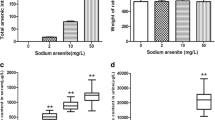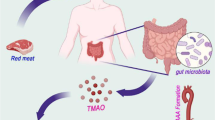Abstract
The aim of the current study was to investigate the effect of excess iodine on rat aorta endothelial cells and the potential underlying mechanisms. Rat aorta endothelial cells were cultured with iodide ion (3506, 4076, 4647, 5218, 5789, 6360, 6931, and 7512 mg/L) for 48 h. Morphological changes of cells were observed with microscope after Wright-Giemsa staining and acridine orange staining. Cell proliferation was determined with 3-(4,5-dimethylthiazol-2-yl)-2,5-diphenyltetrazolium bromide assay, and cell apoptosis was assessed with flow cytometry. The activity of superoxide dismutase (SOD), glutathione peroxidase (GSH-Px), endothelial nitric oxide synthase (eNOS), induced nitric oxide synthase (iNOS), and concentrations of malondialdehyde (MDA), glutathione (GSH), and protein carbonyl in culture medium were determined with colorimetric method. The expression of intercellular adhesion molecule-1 (ICAM-1) and vascular cell adhesion molecule-1 (VCAM-1) was detected by enzyme linked immunosorbent assay. The results showed that excess iodine induced abnormal morphologic changes of cells, inhibited cell proliferation, and increased apoptosis rate. Iodine also reduced the activity of SOD, GSH-Px, and concentrations of GSH and increased the concentrations of MDA and protein carbonyl in a dose-dependent manner. Moreover, excess iodine decreased the activity of eNOS and increased the activity of iNOS and the expression of ICAM-1 and VCAM-1 in culture medium. Our results suggested that excess iodine exposure increased oxidative stress, caused damage of vascular endothelial cells, and altered the expression of adhesion factors and the activity of NOS. These changes may explain the mechanisms underlying excess iodine-induced vascular injury.







Similar content being viewed by others
Abbreviations
- DMEM:
-
Dulbecco’s modified Eagle’s medium
- DMSO:
-
Dimethyl sulfoxide
- ELISA:
-
Enzyme-linked immunosorbent assay
- eNOS:
-
Endothelial nitric oxide synthase
- GSH:
-
Glutathione
- GSH-Px:
-
Glutathione peroxidase
- ICAM-1:
-
Intercellular adhesion molecule-1
- iNOS:
-
Induced nitric oxide synthase
- LDL:
-
Low-density lipoprotein
- MDA:
-
Malondialdehyde
- MTT:
-
3-(4,5-Dimethylthiazol-2-yl)-2,5-diphenyltetrazolium bromide assay
- PBS:
-
Phosphate-buffered saline
- SOD:
-
Superoxide dismutase
- VCAM-1:
-
Vascular cell adhesion molecule-1
References
Zimmermann MB, Jooste PL, Pandav CS (2008) Iodine-deficiency disorders. Lancet 372:1251–1262
Smyth PP, Darke C, Parkes AB et al (1999) Assessment of goiter in an area of endemic iodine deficiency. Thyroid 9:895–901
Burgi H (2010) Iodine excess. Best Pract Res Clin Endocrinol Metab 24:107–115
Zimmermann MB (2013) Iodine deficiency and excess in children: worldwide status in 2013. Endocr Pract 19:839–846
Camargo RY, Tomimori EK, Neves SC et al (2008) Thyroid and the environment: exposure to excessive nutritional iodine increases the prevalence of thyroid disorders in Sao Paulo, Brazil. Eur J Endocrinol 159:293–299
Xia Y, Qu W, Zhao LN et al (2013) Iodine excess induces hepatic steatosis through disturbance of thyroid hormone metabolism involving oxidative stress in BALB/c mice. Biol Trace Elem Res 154:103–110
Zhang L, Teng W, Liu Y (2012) Effect of maternal excessive iodine intake on neurodevelopment and cognitive function in rat offspring. BMC Neurosci 13:121
Danzi S, Klein I (2012) Thyroid hormone and the cardiovascular system. Med Clin N Am 96:257–268
Fazio S, Palmieri EA, Lombardi G et al (2004) Effects of thyroid hormone on the cardiovascular system. Recent Prog Horm Res 59:31–50
Prisant LM, Gujral JS, Mulloy AL (2006) Hyperthyroidism: a secondary cause of isolated systolic hypertension. J Clin Hypertens (Greenwich) 8:596–599
Ichiki T (2010) Thyroid hormone and atherosclerosis. Vascul Pharmacol 52:151–156
Tu J, Hu ZQ, Chen ZB (2013) Endothelial gene expression and molecular changes in response to radiosurgery in in vitro and in vivo models of cerebral arteriovenous malformations. Biomed Res Int. doi:10.1155/2013/408253
Liu ZC, Yu SY (1987) Nutrition and food hygiene. People’s medical publishing house, Bei Jing
Allain P, Berre S, Krari N et al (1993) Use of plasma iodine assay for diagnosing thyroid disorders. J Clin Pathol 46(5):453–455
Ramponi S, Grotti A, Morisetti A et al (2007) Effects of iodinated contrast media on endothelium: an in vitro study. Toxicol In Vitro 21(2):191–196
Dohan O, De la Vieja A, Paroder V et al (2003) The sodium/iodide symporter (NIS): characterization, regulation, and medical significance. Endocr Rev 24(1):48–77
Liu XQ (2011) The role of CLC3 in proliferation and apoptosis of human umbilical vein endothelial cell induced by iodine ion. Dissertation, University of Shandong
Gao J, Lin X, Liu X et al (2013) Effect of combined excess iodine and low-protein diet on thyroid hormones and ultrastructure in Wistar rats. Biol Trace Elem Res 155(3):416–422
Zager RA, Johnson AC, Hanson SY (2003) Radiographic contrast media-induced tubular injury: evaluation of oxidant stress and plasma membrane integrity. Kidney Int 64(1):128–139
Hao ML, Lin XY, Zhao SS et al (2014) Influence of high iodine on apoptosis and related proteins expression of thorax aorta vascular smooth muscle cells in rats. Chin J Environ Health 31(3):210–212
Tsutsui M, Shimokawa H, Otsuji Y et al (2009) Nitric oxide synthases and cardiovascular diseases: insights from genetically modified mice. Circ J 73(6):986–993
Liu VW, Huang PL (2008) Cardiovascular roles of nitric oxide: a review of insights from nitric oxide synthase gene disrupted mice. Cardiovasc Res 77(1):19–29
Balligand JL, Ungureanu-Longrois D, Simmons WW et al (1994) Cytokine-inducible nitric oxide synthase (iNOS) expression in cardiac myocytes. Characterization and regulation of iNOS expression and detection of iNOS activity in single cardiac myocytes in vitro. J Biol Chem 269(44):27580–27588
Blankenberg S, Barbaux S, Tiret L (2003) Adhesion molecules and atherosclerosis. Atherosclerosis 170(2):191–203
Joanta AE, Filip A, Clichici S et al (2006) Iodide excess exerts oxidative stress in some target tissues of the thyroid hormones. Acta Physiol Hung 93(4):347–359
Zhdankin VV, Stang PJ (2008) Chemistry of polyvalent iodine. Chem Rev 108(12):5299–5358
Pereira A, Braekman JC, Dumont JE et al (1990) Identification of a major iodolipid from the horse thyroid gland as 2-iodohexadecanal. J Biol Chem 265(28):17018–17025
Higashi Y, Noma K, Yoshizumi M et al (2009) Endothelial function and oxidative stress in cardiovascular diseases. Circ J 73(3):411–418
Stocker R, Keaney JJ (2004) Role of oxidative modifications in atherosclerosis. Physiol Rev 84(4):1381–1478
Acknowledgment
This work was supported by the National Natural Science Foundation of China (no. 81273016).
Conflict of Interest
The authors declare no conflicts of interest that would prejudice the impartiality of this scientific work.
Author information
Authors and Affiliations
Corresponding author
Rights and permissions
About this article
Cite this article
Zhang, M., Zou, X., Lin, X. et al. Effect of Excessive Potassium Iodide on Rat Aorta Endothelial Cells. Biol Trace Elem Res 166, 201–209 (2015). https://doi.org/10.1007/s12011-015-0264-0
Received:
Accepted:
Published:
Issue Date:
DOI: https://doi.org/10.1007/s12011-015-0264-0




